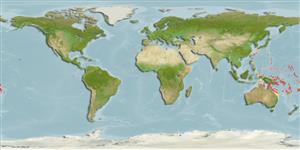>
Blenniiformes (Blennies) >
Tripterygiidae (Triplefin blennies) > Tripterygiinae
Etymology: Helcogramma: Greek, helkos, -eos, -ous = ulcer, sore + Greek, gramma = letter, mark (Ref. 45335); nigra: The specific epithet is from the Latin nigra meaning black. The name refers to the black fins of the males.
Environment: milieu / climate zone / depth range / distribution range
Ecologia
marinhas bentopelágico; intervalo de profundidade 1 - 14 m (Ref. 52308). Tropical
Western Central Pacific: Papua New Guinea, Vanuatu, and Fiji.
Tamanho / Peso / Idade
Maturity: Lm ? range ? - ? cm
Max length : 3.8 cm TL macho/indeterminado; (Ref. 90102)
Descrição suscinta
Chaves de identificação | Morfologia | Morfometria
Espinhos dorsais (total) : 16 - 17; Raios dorsais (total) : 11 - 13; Espinhos anais: 1; Raios anais : 19 - 21; Vértebras: 36 - 38. A species of Helcogramma (sensu Hansen, 1986) with 1-2 symphysial mandibular sensory pores, second dorsal fin spines XIII (two of 26 specimens with XIV), third dorsal fin segmented rays 10-12, last ribs on vertebral centrum 11, vertebrae modally 11+26=37 (value range: 11+25 to 27=36 to 38), pored lateral line scales modally 25 (value range: 23-29), nape scales absent, males with dorsal, caudal and anal fins dark.
Adults inhabit exposed rocky and coralline boulders of coasts (Ref. 90102). Eggs are hemispherical and covered with numerous sticky threads that anchor them in the algae on the nesting sites (Ref. 240). Larvae are planktonic which occur primarily in shallow, nearshore waters (Ref. 94114). Minimum depth from Ref. 58018.
Ciclo de vida ou comportamento de acasalamento
Maturidade | Reprodução | Desova | Ovos | Fecundidade | Larvas
Williams, J.T. and J.C. Howe, 2003. Seven new species of the triplefin fish genus Helcogramma (Tripterygiidae) from the Indo-Pacific. aqua, J. Ichthyol. Aquat. Biol. 7(4):151-176. (Ref. 52308)
Status na Lista Vermelha da UICN (Ref. 130435: Version 2024-1)
Ameaça para os humanos
Harmless
Uso pelos humanos
Ferramentas
Relatórios especiais
Baixar XML
Fontes da internet
Estimates based on models
Preferred temperature (Ref.
123201): 25.5 - 29.4, mean 28.4 °C (based on 964 cells).
Índice de diversidade filogenética (Ref.
82804): PD
50 = 0.5000 [Uniqueness, from 0.5 = low to 2.0 = high].
Bayesian length-weight: a=0.00617 (0.00288 - 0.01322), b=3.04 (2.86 - 3.22), in cm total length, based on LWR estimates for this (Sub)family-body shape (Ref.
93245).
Nível Trófico (Ref.
69278): 3.0 ±0.3 se; based on size and trophs of closest relatives
Resiliência (Ref.
120179): Elevada, tempo mínimo de duplicação da população menor que 15 meses (Preliminary K or Fecundity.).
Fishing Vulnerability (Ref.
59153): Low vulnerability (10 of 100).
